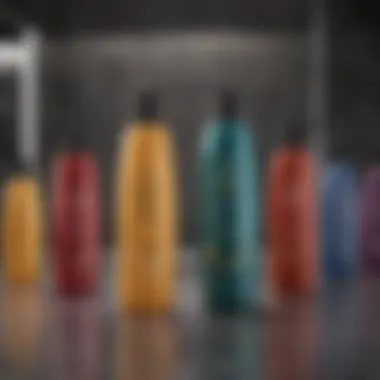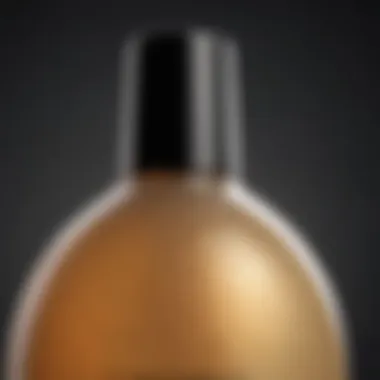Best Shampoo for Transitioning Hair: Expert Guide


Intro
Transitioning hair requires a specific approach to hair care. As women change their hairstyles, whether for aesthetic reasons or to embrace their natural texture, a crucial aspect often neglected is the choice of shampoo. Many factors contribute to the health and manageability of transitioning hair, making it essential to focus on appropriate hair products. In this guide, we will discuss the relevant aspects of selecting a good shampoo for transitioning hair, including ingredients that benefit different hair textures and general usage tips. These insights will help women of all ages understand how to care for their unique hair needs effectively.
Key Trends
Overview of Current Hair Care Trends
The hair care industry is constantly evolving. Currently, there is a noticeable shift towards personalized hair care solutions. Women are looking for products that not only address their specific needs but also resonate with their values, such as sustainability and inclusivity. Additionally, the rise of natural and organic hair products reflects a broader trend towards holistic beauty practices.
Popular Beauty Trends
In tandem with hair care, beauty trends emphasize nurturing rather than masking imperfections. Multi-functional products are gaining traction. For example, shampoos that offer nourishment while effectively cleansing are in great demand. The focus now leans towards ingredients that are beneficial not just for cleansing but also for maintaining overall hair health.
Effective Ingredients for Transitioning Hair
Choosing the right shampoo means understanding what ingredients work best for transitioning hair. Effective shampoos often contain:
- Moisturizing agents like glycerin or aloe vera to hydrate and soften hair.
- Proteins such as keratin or silk to strengthen and repair any damage.
- Natural oils like jojoba or argan oil to promote shine and manageability.
Each ingredient plays a role in catering to the needs of transitioning hair, ensuring maintenance of its health and appearance.
Product Recommendations
When searching for good shampoos, consider options that include the right blend of ingredients. Some standout choices include:
- SheaMoisture Curl and Shine Shampoo – rich in coconut and hibiscus, ideal for nourishing curls.
- Ouidad Advanced Climate Control Shampoo – helps manage frizz in humid weather while keeping hair moisturized.
- Kinky-Curly Come Clean Shampoo – a clarifying option that gently removes product buildup without stripping natural oils.
These products help promote healthy hair during the transitioning phase.
Tips for Usage
To make the most of your shampoo:
- Dilute Shampoo: Mixing with water can reduce harshness and allow for easier application.
- Limit Washing Frequency: Over-washing can lead to dryness. Aim for 2-3 times a week, assessing your hair needs.
- Follow with Conditioner: This step adds moisture back into the hair, balancing the cleansing effect of the shampoo.
"Proper hair care is not just about choosing the right products; it's a lifestyle choice that impacts feminine identity and self-expression."
In summary, effective management of transitioning hair hinges on understanding its unique needs. With the right shampoo and care practices, women can embrace their changing hair with confidence.
Understanding Transitioning Hair
Understanding transitioning hair is crucial for anyone embarking on the journey of changing their hair texture or returning to its natural form. This phase often entails a mix of textures and requires tailored care to manage the transformation effectively. Knowing the specific needs of transitioning hair can lead to better health, vitality, and overall manageability. The right shampoo plays a significant role in this process.
What is Transitioning Hair?
Transitioning hair refers to the process where individuals stop chemically altering their hair, like relaxing or coloring, and allow their natural texture to grow out. This journey often results in a blend of straightened ends and coily roots. It can be a challenging yet rewarding experience. Understanding what transitioning hair is helps in recognizing the types of products and care it requires. The objective is not just to grow out the natural texture, but to also ensure that all strands retain their health throughout this changing journey.
Common Characteristics of Transitioning Hair
Transitioning hair exhibits several distinctive characteristics:
- Texture Variation: One of the most prominent features is the visible contrast between the straightened ends and the new, natural texture at the roots.
- Fragility: Areas where the hair has been treated chemically are often weaker and more prone to breakage, necessitating additional careful handling.
- Dullness: The chemical processes can leave hair looking lifeless. Natural hair growth might appear more vibrant and full of life in comparison.
Understanding these traits is important. It influences the choice of products and the care strategies employed, ensuring that hair remains as healthy as possible.
Challenges Faced During Transitioning
Transitioning hair comes with its own set of challenges:


- Dual Textures: Managing two different textures can be tricky. Finding styles that accommodate both regions is necessary but may require creativity and patience.
- Breakage: The ends, having been processed, are more susceptible to damage, which can hinder progress towards a fully natural look.
- Moisture Retention: Transitioning hair often demands diligent moisture care. Areas can become dry, leading to frizz and increased breakage.
"Navigating the challenges of transitioning hair can be daunting, but understanding the specifics can ease the journey."
In summary, understanding transitioning hair is an essential step for anyone looking to embrace their natural texture. By recognizing its characteristics and challenges, individuals can select the right products and methods to foster hair health and achieve their desired look.
The Importance of Shampoo in Hair Care
Understanding the significance of shampoo in hair care is critical, especially for those dealing with transitioning hair. The right shampoo can greatly affect your hair’s health, enhancing its manageability and appearance. Unlike ordinary hair, transitioning hair often experiences a mixture of textures and may be more susceptible to damage. Thus, selecting a suitable shampoo is more than just a choice; it is a necessity.
Shampoos serve several vital functions in hair care routines. They clean the hair and scalp by removing dirt, excess oils, and product buildup. This cleansing process is essential for maintaining hair health, especially for transitioning hair, which can otherwise become weighed down or frizzy. Moreover, using an appropriate shampoo helps in preparing the hair for subsequent treatments, such as conditioners and leave-ins.
Additionally, various shampoos come with unique properties tailored to different hair needs. For transitioning hair, it is beneficial to utilize shampoos enriched with specific ingredients. This leads to improved moisture retention and less breakage. The right shampoo can also facilitate a smoother transition from chemically treated to natural hair, ultimately promoting hair strength and resilience.
"Shampoo is the first step in maintaining the health of transitioning hair, setting the stage for effective care rituals."
Role of Shampoo in Hair Health
The role of shampoo in hair health cannot be understated. A quality shampoo helps create an optimal environment for the hair and scalp. Many shampoos contain ingredients that directly promote hair health by providing essential nutrients, hydration, and cleansing. For transitioning hair, these benefits are particularly significant.
For example, moisturizing shampoos help combat dryness common in transitioning hair. They generally include hydrating elements that help maintain balance and softness. Conversely, clarifying shampoos assist in thoroughly cleansing the hair and scalp but should be used sparingly, as they may strip natural oils necessary for keeping hair healthy.
When transitioning, it is vital to recognize that using a suitable shampoo can enhance the overall texture of hair. Regular washing with an appropriate product can result in improved elasticity and minimize the risk of breakage.
Types of Shampoos Available
Shampoos come in a variety of types, catering to diverse hair care needs. Understanding these categories can aid in making informed choices.
- Moisturizing Shampoos: These are designed to hydrate and nourish hair, ideal for transitioning hair, which often requires extra moisture. Ingredients such as glycerin and coconut oil are common in these shampoos.
- Clarifying Shampoos: These shampoos are meant for deep cleansing, removing product buildup and impurities. However, they can be harsh, so it’s best to use them infrequently.
- Sulfate-Free Shampoos: Transitioning hair benefits greatly from sulfate-free options. This type avoids harsh sulfates that can strip the hair of natural oils, which is essential for maintaining moisture balance.
- Protein Shampoos: Shampoos containing proteins help strengthen hair, particularly useful during the transitioning phase when the hair is more vulnerable to damage. Ingredients like hydrolyzed keratin play a key role here.
Choosing the right type of shampoo is essential in establishing a routine that enhances the health and appearance of transitioning hair. Each shampoo type offers unique properties that cater to specific hair needs, contributing to a more effective hair care regimen.
Key Ingredients for Transitioning Hair
Transitioning hair necessitates a unique level of care due to its fluctuating textures and the different needs during this period. The selection of appropriate shampoos is guided significantly by their ingredients. Understanding the formulation of shampoos makes it easier to pick what suits your hair type best. Specific components have been recognized for their benefits—moisturizing agents, protein treatments, and sulfate-free formulas. These elements contribute directly to maintaining moisture balance, enhancing strength, and ensuring a gentle cleanse, all of which are crucial during the transitioning process.
Moisturizing Agents
Moisturizing agents are essential in any shampoo intended for transitioning hair. These ingredients help to improve hydration levels while combating dryness, a common challenge faced during this phase. Look for shampoos containing ingredients such as glycerin, shea butter, or aloe vera, as they provide substantial moisture retention.
- Glycerin acts as a humectant, drawing water into the hair strands and helping to keep them hydrated.
- Shea Butter serves to combat dryness with its rich fatty acid content, providing a protective layer on the hair.
- Aloe Vera not only hydrates but also soothes the scalp, reducing the likelihood of irritation, which can be beneficial when trying to maintain healthy roots.
Incorporating these moisturizing agents in shampoo can lead to a noticeable improvement in the texture and overall appearance of transitioning hair. The balance they provide makes hair more manageable, contributing to a healthy look.
Protein Treatments
Protein treatments are vital for transitioning hair as well. They help reinforce the hair structure and restore strength after chemical treatments or heat damage. During the transitioning phase, hair is often more prone to breakage and needs protein for recovery. Ingredients such as hydrolyzed silk, keratin, and wheat protein are effective choices often found in various shampoos.
- Hydrolyzed Silk provides a smooth finish while adding strength and moisture to the hair.
- Keratin is the building block of hair, enabling a repair mechanism that can strengthen individual hair strands.
- Wheat Protein penetrates the hair shaft, improving elasticity and making strands less susceptible to damage.
Building a shampoo routine with protein-rich formulations ensures that transitioning hair can withstand stressors, helping to reduce breakage and support growth during this delicate phase.
Sulfate-Free Formulas
Sulfates, commonly found in many shampoos, can strip natural oils from the hair. For transitioning hair, using sulfate-free formulas is particularly crucial. These shampoos cleanse the hair without removing essential moisture.
When choosing sulfate-free shampoos, look for those that highlight gentle cleansing agents like cocamidopropyl betaine or decyl glucoside.
- Cocamidopropyl Betaine provides a mild cleaning action, helping to reduce the risk of irritation.
- Decyl Glucoside is plant-derived and offers effectiveness in cleaning while being incredibly mild.


Opting for sulfate-free options leads to healthier hair that maintains its natural oils, contributing to overall shine and manageability. Many users notice that choosing these formulations results in a more pleasant washing experience, allowing for a better overall routine.
The right combination of moisturizing agents, protein treatments, and sulfate-free formulas can set the stage for beautiful, strong hair through the transitioning process.
Product Recommendations for Transitioning Hair
Understanding which shampoos work best for transitioning hair is crucial for maintaining its health and beauty. Selecting the right products not only supports hair growth but also helps in managing the unique characteristics of transitioning hair. Shampoos play an integral role in cleansing while providing essential nutrients that cater to the delicate balance required in this phase. The focus should be on functionality, ingredients, and personal preferences.
Best Shampoos for Moisture Retention
Maintaining moisture is key for transitioning hair. Products enriched with hydrating ingredients such as glycerin, aloe vera, and natural oils are highly recommended. Some of the best options include:
- SheaMoisture Coconut & Hibiscus Curl & Shine Shampoo: Promotes moisture retention and enhances curl definition, making it suitable for naturally curly hair types during the transition.
- Maui Moisture Heal & Hydrate Shear Butter Shampoo: Infused with a mix of aloe vera and coconut water, it provides deep hydration without weighing the hair down.
- Giovanni 50:50 Balanced Hydrating-Clariying Shampoo: This shampoo balances moisture and clarifies simultaneously, ensuring that transitioning hair remains clean and hydrated.
When selecting a moisture-retaining shampoo, look for formulations that avoid harsh sulfates. The presence of moisturizing components should be prioritized for a well-rounded hair care routine.
Top Protein-Enriched Shampoos
Protein is essential for restoring the strength and resilience of transitioning hair. During this phase, hair often experiences changes that can lead to breakage. Consider these shampoos:
- Aphogee Keratin 2 Minute Reconstructor: This is a deep treatment shampoo that strengthens hair while providing moisture.
- TRESemmé Botanique Nourish & Replenish Shampoo: Crafted with a blend of natural ingredients and proteins, it helps fortify hair without any buildup.
- Mizani True Textures Moisture Replenish Shampoo: It delivers moisture and strength, helping to improve the elasticity of the hair.
Strive to incorporate protein-enriched shampoos regularly but in moderation to avoid protein overload. Look for products with a balance of protein and moisture.
Recommended Sulfate-Free Shampoos
Sulfates can be damaging, especially to transitioning strands that are susceptible to breakage and dryness. Sulfate-free alternatives help maintain natural oils in the hair while providing effective cleansing. Highly recommended options include:
- Loreal EverPure Sulfate-Free Moisture Shampoo: Specifically designed for color-treated hair, it is gentle and hydrating.
- Paul Mitchell Awapuhi Wild Ginger Moisturizing Shampoo: This luxurious shampoo is sulfate-free and imparts moisture while cleaning the scalp effectively.
- Aveeno Scalp Soothing Apple Cider Vinegar Blend Shampoo: Clarifies and balances the scalp without sulfates, using natural ingredients for gentle cleaning.
When transitioning, choosing sulfate-free shampoos can help retain the natural oils and moisture essential to the health of your hair.
How to Use Shampoo Effectively
Using shampoo properly is vital for maintaining the health of transitioning hair. This process is often more nuanced than just applying shampoo and rinsing it off. Understanding the most effective methods of application and the right frequency can significantly impact hair texture and moisture retention. Shampoos designed for transitioning hair require a careful approach, as they cater to a range of needs.
Method of Application
Applying on dry hair
Applying shampoo directly on dry hair is an interesting approach gaining popularity among many. This method is particularly effective for curly or coily hair types that tend to be more frail. When shampoo is applied to dry hair, it can help to break down product buildup and dirt without stripping the hair of essential moisture. This pre-treatment method allows the ingredients to penetrate the hair shaft more effectively.
One key characteristic of this technique is that it enables a gentler cleansing process. Instead of immediately introducing water, shampoo adheres better to the buildup, lifting away dirt and oils. This can be a beneficial choice for those who experience excessive dryness or damage. However, one must be cautious. If not rinsed well, residue can linger, potentially leading to an unwashed feeling in the hair.
Applying on wet hair
Conversely, applying shampoo on wet hair is the traditional method. This approach allows for a more straightforward and expected cleansing action. As water opens up the hair cuticles, the shampoo can easily lift oils and impurities. This method is quick and well-understood by most. Additionally, it can be less intensive on the scalp as it reduces friction during application.
A significant advantage of wet application is that it can be more refreshing. Users often find it easier to work the product through wet strands. However, for those with transitioning hair, it may not always address the needs for deep cleansing effectively. Therefore, it might not extract all buildup as well as applying on dry hair. Ultimately, it depends on individual preferences and hair needs.
Frequency of Washing
The frequency with which you wash your hair can influence its overall health, especially when transitioning. Some may feel tempted to wash daily to keep hair looking clean. But for many, particularly those with transitioning textures, this habit can lead to over-drying.
Finding a balance is essential. Depending on your hair type, washing 1-3 times per week may be ideal. Over-washing can strip the hair of its natural oils, essential for maintaining moisture balance. Alternatively, under-washing may lead to buildup of products and dirt. To determine the best frequency, consider your lifestyle, hair type, and how your hair reacts to different environments. Observing these factors can enhance your hair health and support the transition process.
Complementing Shampoo with Other Products
Choosing the right shampoo for transitioning hair is just one part of a comprehensive hair care strategy. To achieve optimal health and vibrancy, complementing shampoos with other products is essential. These additional products play a crucial role in nourishing and managing hair, addressing the unique challenges faced during the transition phase. This section explores the significance of incorporating conditioners, leave-ins, oils, and enhancing treatments into your routine.


Conditioners and Leave-Ins
Conditioners are vital allies when it comes to maintaining the integrity of transitioning hair. After cleansing, a good conditioner can help restore moisture and provide slip, making it easier to detangle and style without causing breakage. Look for conditioners rich in natural oils, botanicals, and hydrating agents. These ingredients can significantly enhance the softness and manageability of the hair.
Leave-in conditioners serve a similar purpose but offer additional benefits. By applying a leave-in conditioner, you can ensure all-day hydration without weighing down the hair. Here are some key benefits of using conditioners and leave-ins:
- Moisture retention: Helps in keeping the hair hydrated throughout the day.
- Protection: Shields hair from environmental factors like humidity and heat.
- Improved texture: Contributes to making hair smoother and more manageable.
The application of conditioners and leave-ins should be tailored based on personal preference and hair needs. For instance, applying a leave-in on damp hair can lock in moisture effectively.
Oils and Treatments to Enhance Moisture
Incorporating oils and specialized treatments into a hair care routine can dramatically improve the health of transitioning hair. Oils, such as argan, coconut, and jojoba, not only provide necessary nutrients but also help seal moisture, making it a critical step for those facing dryness or frizz. Treatments such as deep conditioning masks can deliver intense hydration and repair, especially needed during the transitioning period when hair might feel more fragile.
Benefits of using oils and treatments include:
- Nourishment: Oils penetrate the hair shaft and nourish from within, promoting overall health.
- Moisture sealing: Locks in moisture to combat dryness caused by environmental stressors.
- Frizz control: Helps to smooth the cuticle, reducing the appearance of frizz.
Consider combining oil treatments with your shampoo or using them as pre-wash treatments. This approach can enhance the benefits of other products, ensuring that transitioning hair remains healthy and resilient throughout the process.
"The right combination of products is key to achieving and maintaining vibrant, healthy hair during transitions."
Lifestyle Considerations for Hair Health
When it comes to maintaining the health of transitioning hair, lifestyle factors play a crucial role. These factors range from nutrition to environmental influences, each significantly affecting the hair’s condition, texture, and overall appearance. Recognizing and integrating these considerations into a hair care regime can enhance the effects of good shampoo and treatments. By focusing on these elements, women can achieve a more manageable and healthier mane during their transitional phase.
Diet and Nutrition
A well-balanced diet is paramount for sustaining healthy hair. Nutrient-rich foods provide the minerals and vitamins essential for hair growth and repair. Below are key nutrients to prioritize:
- Protein: Hair is primarily made of protein, so including sources like lean meats, fish, eggs, and legumes is crucial.
- Omega-3 Fatty Acids: Found in fatty fish, walnuts, and flaxseeds, these fats help maintain moisture in the scalp.
- Iron and Zinc: Both minerals support healthy hair. Foods like spinach, nuts, and seeds are rich in these nutrients.
- Vitamins A, C, D, and E: These vitamins contribute to healthy cell production and protect the hair from damage. Sources include fruits, vegetables, and dairy products.
Maintaining hydration is also vital. Drinking adequate water supports overall health and keeps the hair hydrated, reducing brittleness and while enhancing its shine. A diet lacking these essentials can lead to hair weakness, breakage, and a longer transitioning process.
Managing Environmental Factors
Environmental factors can significantly impact transitioning hair. Pollution, humidity, and sun exposure all can cause damage. Here are some methods to manage these influences:
- Use Protective Styles: Consider styles that minimize exposure to harsh elements. Braids or buns can protect the ends of your hair from pollution.
- Limit Sun Exposure: UV rays can dry out hair. Wearing hats or using UV protectant hair products can help shield your hair.
- Maintain Indoor Humidity: During dry seasons, using a humidifier indoors can help maintain moisture levels in hair and skin.
- Shampoo Wisely: Use products that are designed to combat the effects of environmental factors, particularly those containing moisturizing agents.
Keeping your hair healthy is not solely about the products you apply but also about your daily environment and choices.
By paying attention to diet and managing environmental challenges, individuals can significantly improve transitioning hair's health, ensuring that it looks and feels its best. It is essential to view hair care as a holistic practice, where lifestyle adjustments can provide the necessary support for beautiful hair.
The End
Selecting the right shampoo is crucial for women with transitioning hair. Transitioning hair often endures various challenges, including texture changes and potential damage. Therefore, the usage of appropriate hair care products becomes paramount to ensure health and vitality.
In this article, we discussed several specific factors that influence shampoo choice for transitioning hair. These factors include the need for gentle cleansing, moisture retention, and the importance of nourishing ingredients. Proper shampoo can help maintain the balance between the natural oils and the hydration necessary for strong, resilient hair.
Moreover, we considered the synergy between shampoo and other hair care products, emphasizing a holistic approach to hair health. A well-rounded routine can dramatically improve hair texture, manageability, and overall appearance.
The benefits of using a suitable shampoo extend beyond mere aesthetics. Healthy hair can boost confidence and positively impact one's lifestyle. It highlights the necessity of making informed decisions when selecting shampoo, as poorly chosen products can lead to frustration and setbacks in the transitioning process.
Taking into account the nuances of transitioning hair, it becomes evident that a thoughtful selection of shampoos can pave the way for a successful hair journey. As you navigate through your hair care routine, always prioritize the health of your hair above all else.
"Invest in your hair; it is the crown you never take off."
Recap of Key Points
- Transitioning hair experiences distinct challenges that require careful product selection.
- The role of shampoo is not merely cleansing; it must also nourish and hydrate.
- Moisture-retaining and nourishing ingredients make a significant difference in hair health.
- Complementing shampoo with conditioners and treatments is essential for maintaining vitality.
- A well-informed approach leads to better outcomes for transitioning hair.
Final Thoughts on Selecting Shampoo
Pay attention to individual hair response; no single product works for everyone. Embrace the journey towards healthy hair and prioritize maintaining a routine that fosters growth and resilience. The effort invested in selecting a good shampoo will reflect in the overall well-being of your transitioning hair.



